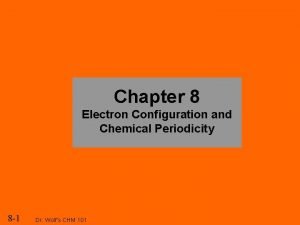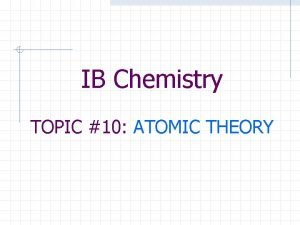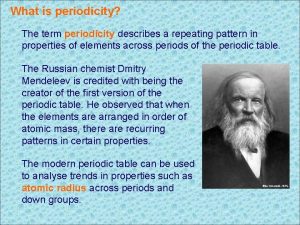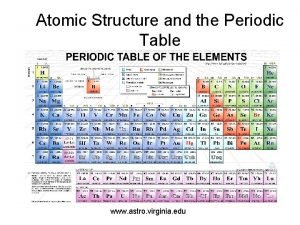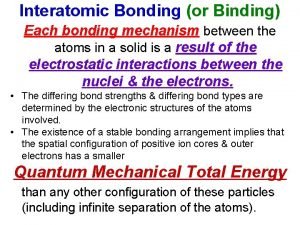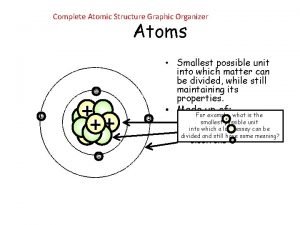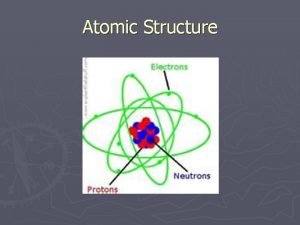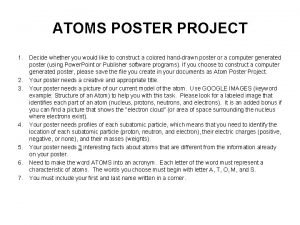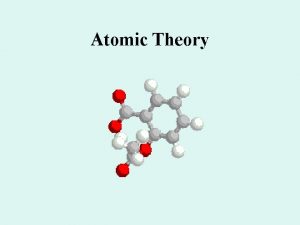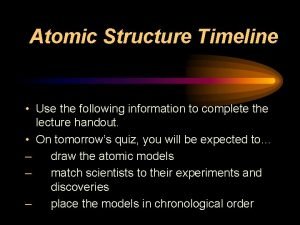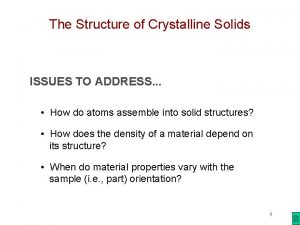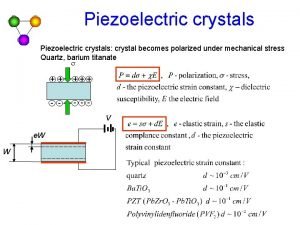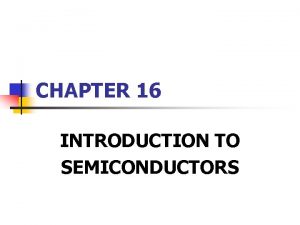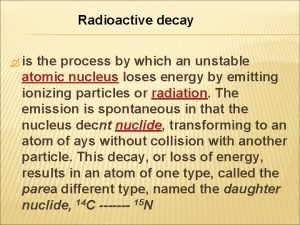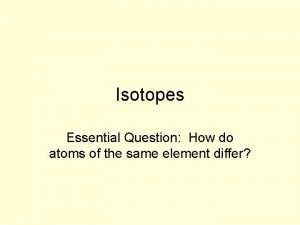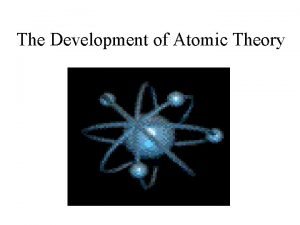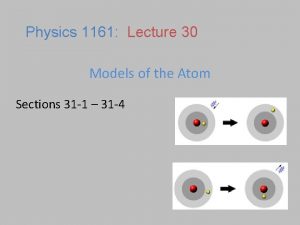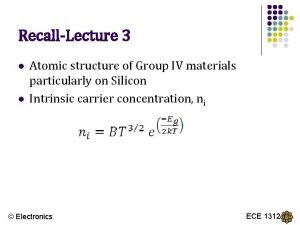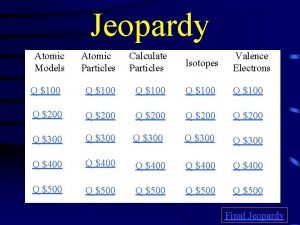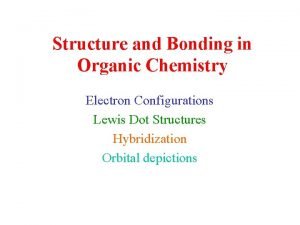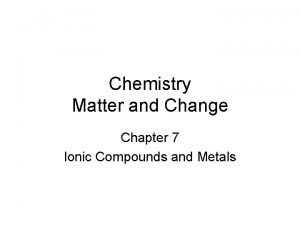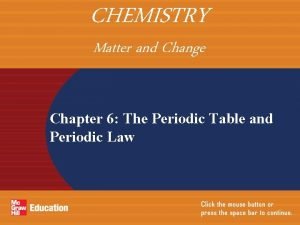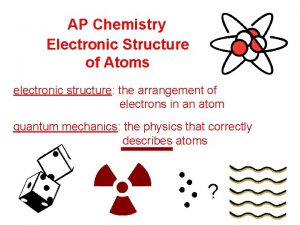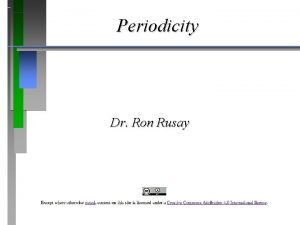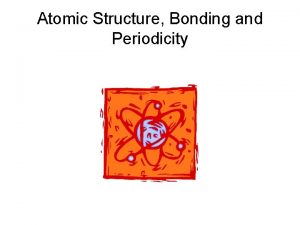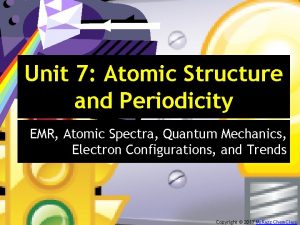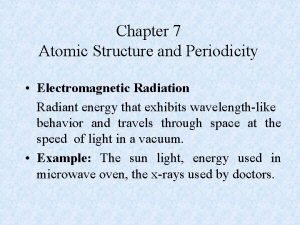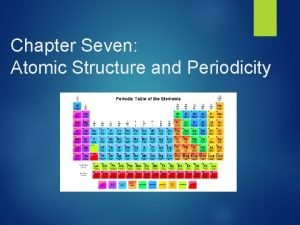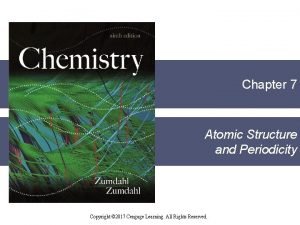AP Chemistry Chapter 7 Atomic Structure and Periodicity





































































- Slides: 69

AP Chemistry: Chapter 7 Atomic Structure and Periodicity

§In this unit, we will ask ourselves the same question that scientists asked once they believed in the atom; “What is the nature of the atom? ” We will look not only at how the atom is structured, but also how this relates to the arrangement of the periodic table.

Electromagnetic Radiation §radiant energy that exhibits wavelike behavior and travels through space at the speed of light in a vacuum.

§ Wavelength ( ) -distance between two consecutive peaks or troughs in a wave. § Frequency ( ) -number of waves per second that pass a given point in space. § Speed – all EM radiation travels at the speed of light in a vacuum

As the wavelength decreases, frequency increases. = c § measured in m § measured in s-1 or Hz § c speed of light 3. 0 x 108 m/s

Ex. The yellow light given off by a sodium lamp has a wavelength of 589 nm. What is the frequency of the radiation? 589 nm 1 m = 5. 89 x 10 -7 m 109 nm = c/ = 2. 998 x 108 m/s = 5. 09 x 1014 s-1 5. 89 x 10 -7 m

• Until the early 1900’s, it was believed that matter and energy were very different. Matter was composed of particles and energy was composed of waves. • In 1901, Max Planck found that when solids were heated strongly, they absorbed and emitted energy. • He determined that energy can be gained or lost only in integer multiples of h. • h is Planck’s constant = 6. 626 x 10 -34 J. s • This showed that energy was quantized or made of “packets”. ΔE =h measured in cycles/second, simplified to s-1 or Hz

Ex. Calculate the smallest increment of energy (the quantum of energy) that an object can absorb from yellow light whose wavelength is 589 nm. E = h

Einstein studied the photoelectric effect whereby light of sufficient frequency shining on a metal causes current to flow. The amplitude of the radiation was not important, the frequency was.

This told him that the light must be in particles, each having a given energy. Einstein proposed that electromagnetic radiation can be viewed as a stream of particles called photons. • Einstein’s special theory of relativity: E = mc 2 • Matter and energy are different forms of the same special entity. • Energy of a photon: E = h λ = h/m m = mass in kg v = velocity in m/s h = Planck’s constant = 6. 62 x 10 -34 J. s Ephoton =hc/λ measured in m c speed of light 3. 00 x 108 m/s h = Planck’s constant = 6. 626 x 10 -34 J. s


We can combine this equation with the equation for waves to determine the mass of a photon. This is called the de. Broglie equation. De. Broglie’s equation is used to find the wavelength of a particle. It was determine that matter behaves as though it were moving in a wave. This is important in small objects such as electrons but is negligible in larger objects such as baseballs. Since mass is in the denominator or the equation, the larger the mass, the shorter the wavelength. Heavy objects have very short wavelengths.

§ PES uses the energy from electrons emitted via the photoelectric effect to gain information about the electronic structure of a substance.

§ When light of a certain frequency is shone onto a sample, there a limited number of electrons emitted. The energy of these emissions reflect the energy (and energy levels) in an atom § When the kinetic energy of the emitted electron is subtracted from the energy of the light photons, the resulting value is the ionization energy of that particular electron. § The photons used for photoelectron spectroscopy range from ultraviolet light to X-rays. Analysis of photoelectron spectra for a single element can give us information about the shells and subshells of electrons and the number of electrons in each.

§ The x-axis has units of ionization energy or binding energy of the electron. § Electrons closer to the nucleus have greater Coulombic attraction and thus have a higher ionization energy. § The energy scale at the bottom may change and units vary, so all that is needed is interpretation of the diagram, not details. § The height of the peak indicates the number of electrons in the atom having that energy (the number of electrons in a sublevel).

What element is represented here? Potassium What about this one?

Let’s try another one! Note: the 1 s peak has been omitted. Phosphorus Last one!

§ These peaks all occur at energy level 4. What does each peak represent? § How many electrons are shown by each peak? § Discuss the type of energy present at each peak. Why is it high or low?

§When EM radiation is separated into its single wavelength components a spectrum is produced. White light produces a continuous spectrum (rainbow) when passed through a prism.

§ Some emitters of light radiate only certain colors and wavelengths. This produces a bright line spectrum. § When various gases at low pressures are put in tubes and a high voltage is applied, they glow in various colors. § If this light is passed through a prism, a series of lines of color is produced. This series identifies the element.



§ Niels Bohr found that the absorptions and emissions of light by hydrogen atoms correspond to energy changes of electrons within the atom. Bohr proposed that the electron in hydrogen travels only in certain allowed orbits. § Bohr calculated the energy differences between these orbits and predicted the wavelengths at which lines would be found.

§ His research worked great with the hydrogen atom but did not work correctly for polyelectronic atoms. § Polyelectronic atoms- atoms with more than one electron (anything beyond hydrogen) § Bohr developed an equation that could be used to find the change in energy of a hydrogen electron as it goes from one energy level to another: § 2. 178 x 10 -18 is called the Rydberg constant.

E=-2. 178 x 10 -18 J = -4. 084 x 10 -19 J E = hc= 4. 084 x 10 -19= 6. 626 x 10 -34(2. 998 x 108) = 4. 864 x 10 -7 m or 486. 4 nm

§ By the mid-1920’s de Broglie realized that the Bohr model was not able to be used with other atoms. Thus he, Erwin Schrödinger and Werner Heisenberg began work on a wave mechanical model of the atom. § The electron is visualized as a standing wave (opposite of a traveling wavelike a vibrating guitar string instead of an ocean wave). § This model assumes that the electrons must exist in half-wave increments, thus there are finite positions for each electron.

• A specific wave function - -(function of the x, y and z coordinates of the electron's location in space) became known as an orbital. The orbital represents the mathematically calculated area of probability in which an electron can expect to be found at least 90% of the time. • Warner von Heisenberg put forth in his uncertainty principle that there is a fundamental limitation to just how precisely we can know both the position and momentum of a particle at a given time. This is negligible with macroscopic objects such as a baseball but very important with an electron.

The accepted definition of the size of the hydrogen 1 s orbital is the radius of the sphere that encloses 90% of the total electron probability.

Defines the "address" of an electron. 7. 6 Quantum Numbers

There are four quantum numbers that describe the position of any electron Principle Quantum Number (n) *Energy level or “shell” *as n increases, energy increases Azimuthal Quantum Number (l) *shape of the orbital *s = sphere (2 e-), p = peanut (6 e-), d = donut or daisy (10 e-), f = fancy (14 e- ) Magnetic Quantum Number (ml) *orientation of orbitals in space (x, y, or z) Spin Quantum Number (ms) *direction of electron spin (clockwise or counterclockwise) 1 0=s 0 +½ or -½ 2 0 = s, 1 = p -1, 0, 1 +½ or -½ 3 0 = s, 1 = p, 2 = d -2, -1, 0, 1, 2 +½ or -½ 4 0 = s, 1 = p, 2 = d, 3 = f -3, -2, -1, 0, 1, +½ or -½ 2, 3 5 0 = s, 1 = p, 2 = d, 3 = f -3, -2, -1, 0, 1, +½ or -½ 2, 3

The Principle Quantum Number (n) §Describes the energy level that an electron is in.

The Azimuthal Quantum Number 0=s one orbital (holds 2 electrons) spherical shape 1=p three orbitals (holds 6 electrons) “peanut” or dumbbell shape 2=d five orbitals (holds 10 electrons) cloverleaf shape (4 of 5) 3=f seven orbitals (holds 14 electrons) more complex shapes


“D” OR DAISY ORBITALS

“F” OR FANCY ORBITALS

3. Magnetic quantum number (ml) * -l to +l , including 0 * orientation of the orbital in space 4. Spin quantum number (ms) * +1/2, -1/2 * direction of electron spin


Practice: Determine if these quantum numbers are possible for the outer electrons in these elements. §Vanadium (4, 0, 0, +½) §Sulfur (3, 1, 2, +½) §Cerium (5, 0, 0, -½)

Practice determining possible sets of four quantum numbers! Which of the following sets of quantum numbers (n, l, ms) best describes the valence electron of highest energy in a groundstate gallium atom (atomic number 31)? (A) 4, 0, 0, 1/2 (B) 4, 0, 1, 1/2 (C) 4, 1, 1, 1/2 (D) 4, 1, 2, 1/2 (E) 4, 2, 0, 1/2

§ Orbitals have regions of high electron probability and regions of zero electron probability. Areas of zero electron probability are called nodes. § Degenerate -orbitals that are equal in energy. Ex. All three 2 p orbitals are degenerate.

§ In a given atom, no two electrons can have the same set of four quantum numbers. An orbital can only hold two electrons, and they must have opposite spins (creating two magnetic moments).

§ When an atom has more than one electron, these electrons tend to repel each other. The effect of the electron repulsions is to reduce the nuclear charge (pull of the nucleus on the electron).

§ Zeff = Zactual - effect of e- repulsions § Each electron in an atom has its own value of Zeff which can be calculated from the experimental energy required to remove that electron from the atom. § Shielding- the effect by which the other electrons screen or shield a given electron from some of the nuclear charge. § Ex. Zeff for the 3 s electron in Na is 1. 84, the Zeff for a 1 s electron is 10. 3.

§ A 3 s electron has a small but significant chance of being close to the nucleus. § Most penetration ns > np > nd > nf least penetration The Radial Probability Distribution for the 3 s, 3 p, and 3 d Orbitals

Electrons fill orbitals in order of increasing energy. Because of the penetration effect, electrons fill (n+1)s before nd. ((n+1)s has lower energy). For example, if “n” is 4, then an electron would fill 5 s before filling 4 d.

§ Zeff increases for a 1 s electron going form H to He but decreases form He to Li because 1 s electrons are effective in shielding the 2 s electron. § Zeff increases from Li to Be § Zeff decreases from Be to B § Zeff increases from B to N § Zeff decreases from N to O because one 2 p orbital is doubly occupied § Zeff increases from O to Ne



§ Originally, four elements were suggested by the Greeks; earth, air, fire and water. § Mendeleev, a Russian chemist, was the first to organize elements by their atomic mass and to organize them by their physical characteristics. § Moseley later organized the periodic table by atomic number instead of mass.

§ Aufbau principle- As protons are added one by one to the nucleus, electrons enter orbitals of lowest energy first. § In its ground state, atoms have electrons in the lowest energy orbitals. The order that the orbitals fill is: 1 s, 2 p, 3 s, 3 p, 4 s, 3 d, 4 p, 5 s, 4 d, 5 p, 6 s, 4 f, 5 d, 6 p, 7 s, 5 f, 6 d

§ Valence electrons- electrons in the outermost principle quantum number § Core electrons- inner electrons



2 2 6 2 3 1 s 2 s 2 p 3 s 3 p Atoms of an element, X, have the electronic configuration shown above. The compound most likely formed with magnesium. (A)Mg. X (B) Mg 2 X (C) Mg. X 2 (D) Mg 2 X 3 (E) Mg 3 X 2

Questions 6 -9 (A) 1 s 22 p 53 s 23 p 5 (B) 1 s 22 p 63 s 23 p 6 (C) 1 s 22 p 62 d 103 s 23 p 6 (D)1 s 22 p 63 s 23 p 63 d 5 (E)1 s 22 p 63 s 23 p 63 d 34 s 2 6. An impossible electron configuration C 7. The ground-state configuration for the atoms of a transition element D 8. The ground-state configuration of a negative ion of a halogen B 9. The ground-state configuration of a common ion of an alkaline earth element E

Questions 11 -14 (A) Heisenberg uncertainty principle (B) Pauli exclusion principle (C) Hund’s rule (principle of maximum multiplicity) (D) Shielding effect (E) Wave nature of matter 11. Can be used to predict that a gaseous carbon atom in its ground state is paramagnetic. C 12. Explains the experimental phenomenon of electron diffraction. E 13. Indicates that an atomic orbital can hold no more than two electrons. B 14. Predicts that it is impossible to determine simultaneously the exact position and the exact velocity of an electron. A

Which of the following represents the ground state electron configuration for the Mn 3+ ion? (Atomic number Mn = 25) (A)1 s 22 p 63 s 23 p 63 d 4 (B)1 s 22 p 63 s 23 p 63 d 54 s 2 (C)1 s 22 p 63 s 23 p 63 d 24 s 2 (D)1 s 22 p 63 s 23 p 63 d 84 s 2 (E)1 s 22 p 63 s 23 p 63 d 34 s 1

§ Ionization energy (IE)- energy required to remove an electron from a gaseous atom or ion. § X(g) X+(g) + e§ A measure of how much work it is to remove an electron or how tightly the electron is held by the nucleus. § Units are usually k. J/mol § Ionization Energy depends mainly on two factors: § The effective nuclear charge § The average distance of the electron from the nucleus

§ Ionization energy takes a large jump going from a valence electron to a core electron. The second ionization energy of sodium is much higher than the first. The third ionization energy of magnesium is much higher than that of the first and second electron. Core electrons are much more tightly held than valence electrons.

§ The first ionization energy generally increases going from left to right across a period (very similar to Zeff). It decreases going down a group because electrons being removed are farther from the nucleus. § Exceptions to these general trends occur at group 3 (shielding of p electron by s electrons) and group 6 (paired electron repulsion). § Atoms with a low IE 1 tend to form cations during reactions, whereas those with a high IE 1(except noble gases) tend to form anions. § Metals have low IE. Nonmetals have high IE and very negative EA. Density generally increases going down the periodic table because the atomic number increases faster than the atomic size.


§ The energy associated with the addition of an electron to a gaseous atom -If the addition is exothermic, EA is negative. The more negative, the greater the amount of energy released. Electron Affinity (EA)

In going down a group, EA generally becomes more positive (less energy released) because the electron is farther from the nucleus. There are many exceptions. EA generally becomes more negative going across a period (again, many exceptions)

§ Decreases going from left to right across a period because Zeff increases from left to right. § Increases going down a group because of larger orbitals. Zeff stays about the same because of shielding.


Metals have low IE. Nonmetals have high IE and very negative EA. Density generally increases going down the periodic table because the atomic number increases faster than the atomic size.

Transition Metal Size and Lanthanide Contractions The variation in size as we go across a row of transition metals is much less than among the representative elements. This is because electrons are being added to an inner shell as the nuclear charge gets larger.

The Lanthanide Contraction § A similar phenomenon occurs among the inner transition metals (Ex. lanthanides) The lanthanides fall between La and Hf, La last fills the 5 d 1 electron, Ce ends in 5 d 1 4 f 1. In this 6 th period we have a much larger decrease in size occurring between La and Hf because of the intervening lanthanide elements. This additional decrease in size is known as the lanthanide contraction. It causes Hf to be the same size as Zr, even though Hf is below Zr. § All of the rest of the transition elements in the 6 th period are nearly the same size as the elements above them in the fifth period. This causes the 6 th period transition metals to be extremely dense. This even influences lead and bismuth beyond the transition metals.

 Ap chemistry chapter 7 atomic structure and periodicity
Ap chemistry chapter 7 atomic structure and periodicity Ap chemistry atomic structure and periodicity
Ap chemistry atomic structure and periodicity Chapter 7 atomic structure and periodicity
Chapter 7 atomic structure and periodicity Atomic structure and properties ap chemistry
Atomic structure and properties ap chemistry 1s 22 s22 p63 s2
1s 22 s22 p63 s2 Electronic configuration of mo (z=42)
Electronic configuration of mo (z=42) First ionization energy of calcium
First ionization energy of calcium What is z in atomic structure
What is z in atomic structure What is periodicity
What is periodicity Thsteps quick reference guide
Thsteps quick reference guide Ikan euryphagic
Ikan euryphagic Chemsheets periodicity
Chemsheets periodicity Aap bright futures periodicity schedule
Aap bright futures periodicity schedule Ionization energy atomic radius
Ionization energy atomic radius Filariae
Filariae Relative formula mass of hcl
Relative formula mass of hcl Isotope abundance formula
Isotope abundance formula Atomic
Atomic Periodic table trend
Periodic table trend Periodic table ionic size
Periodic table ionic size Atomic number vs atomic radius
Atomic number vs atomic radius Chapter 4 atomic structure vocabulary
Chapter 4 atomic structure vocabulary Atomic structure
Atomic structure Structure of an atom
Structure of an atom How to use ape man
How to use ape man Inter atomic bonding
Inter atomic bonding Functional groups ib chemistry
Functional groups ib chemistry Inorganic vs organic chemistry
Inorganic vs organic chemistry How electrons are arranged in an atom
How electrons are arranged in an atom Democritus atomic model diagram
Democritus atomic model diagram Atomic structure of a conductor
Atomic structure of a conductor Atoms graphic organizer
Atoms graphic organizer Models of the atom timeline
Models of the atom timeline Z atomic symbol
Z atomic symbol Tungsten atomic structure
Tungsten atomic structure What scientist discovered the electron
What scientist discovered the electron Atom poster project
Atom poster project Atomic structure graphic organizer
Atomic structure graphic organizer Atomic model schrodinger
Atomic model schrodinger Dalton atom modeli
Dalton atom modeli Atomic history webquest
Atomic history webquest Crystalline and non crystalline materials
Crystalline and non crystalline materials Piezoelectric crystal atomic structure
Piezoelectric crystal atomic structure Boardworks atomic structure
Boardworks atomic structure Semiconductor atomic structure
Semiconductor atomic structure Atomic structure
Atomic structure Magnesium element drawing
Magnesium element drawing What is this
What is this Isotopes labeled
Isotopes labeled Discovery of atomic structure
Discovery of atomic structure What is an atom
What is an atom Bohr's radius
Bohr's radius Atomicity
Atomicity Atomic structure
Atomic structure How many neutrons does francium have
How many neutrons does francium have Aristotle democritus
Aristotle democritus Structure and bonding in organic chemistry
Structure and bonding in organic chemistry Chemistry matter and change chapter 7
Chemistry matter and change chapter 7 Chemistry: matter and change chapter 10 the mole answer key
Chemistry: matter and change chapter 10 the mole answer key Chapter 8 review describing chemical reactions
Chapter 8 review describing chemical reactions Chapter 9 chemical names and formulas answer key
Chapter 9 chemical names and formulas answer key Chemistry matter and change chapter 7
Chemistry matter and change chapter 7 Chemistry matter and change chapter 6
Chemistry matter and change chapter 6 Chapter 10 study guide the mole
Chapter 10 study guide the mole Chemistry matter and change chapter 2 answer key
Chemistry matter and change chapter 2 answer key Anatomy and physiology chapter 2
Anatomy and physiology chapter 2 7 ionic and metallic bonding practice problems
7 ionic and metallic bonding practice problems Ap chemistry electronic structure of atoms
Ap chemistry electronic structure of atoms Structural ambiguity examples
Structural ambiguity examples Deep structure
Deep structure





